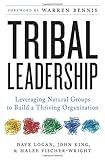
Tribal Leadership is a guide to using natural groups within an organization to create more effective leadership. This concept in this book is slightly different to that of Seth Godin’s “Tribes”, but is an effective complement with a similar core message – an effective organization needs happy people all working towards a focused goal. Seth mentioned Tribal Leadership in Tribes, and I happened to stumble upon it in a discount book store.
The authors gauge organizations into five tribal stages, starting from misanthropic groups of “Stage One” tribes, through to the sort of altruistic “Stage Five” tribes which the authors describe as “pure leadership, vision, and inspiration”. Interestingly, this isn’t some sort of self-help checklist you’re supposed to follow to reach enlightenment but a way to recognize the motivations and concerns of the tribes at various levels of a company.
The book emphasizes that for an organization’s workers to be truly motivated, the organization has to be driven by a noble cause. “Core Values” is not just some Dilbert-esque item to be checked off for a company to be complete – There has to be an actual reason for the people you work with to want to continue doing what they do. As the organization grows and creates tribal leaders at the stage four and five levels, they create what the authors describe as “triads”.
Triads
The concept of the ‘Triad’ will be familiar to anyone who’s read Keith Ferrazzi’s ‘Never Eat Alone’. The Triad is an influential person creating a relationship between two people they know, and then politely moving on. The distinction is that this creation holds no immediate benefit for the person making the introduction and indicates that tribes within the company are moving beyond the individualistic culture of “I’m great” of stage three type tribes towards the “we’re great” atmosphere of stage four and five.
Summary
I’d recommend this book as a separate viewpoint from Seth Godin’s work on the power of tribes. The motivation is more of an internal analysis of an organization than a rabble-rousing call to escape corporate life. The book has several interesting case studies of people and organizations at various developmental stages, and insightful commentary on how to influence tribal direction. Particularly amusing is an interview with Gary Cole, the actor who plays boss-from-hell Bill Lumbergh in the movie “Office Space”. If you were going to pick between this and “Tribes”, I’d say I enjoyed ‘Tribes” more – but got a lot out of both.